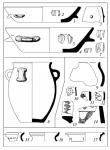Summary (English)
The site is situated at the north-east part of the Uzhgorod (microdistrict of Horyany). It is interpreted as the location of the Slavic town of Ung, known from annals, which was captured by the Ugric. The main objectives of this excavation season were to find out the date of the construction of the hillfort and to establish the chronology of the site.
Three sondages 2 × 2 m in size and a trench measuring 36 × 2 m. were carried out. There were also two sondages at the north steep bank. The steep bank of the slope had been accentuated in the medieval period. There was nothing to confirm existence of the hill fort in Late Roman times. Some objects from the trench 3 and sondage 3confirmed the chronology of the site. There were Neolithic pottery, obsidian flakes and nuclei in the bottom layer (0,4–0,6 m depth). Above these were sherds and the remains of a black-polished vessel with a handle in the second, Hallstatt layer. There was also pottery of the 3–4th cent. AD in this layer represented by fragments of hand-made pots, gray-polished bowls with stamped ornament and pithoi. This assortment of pottery is typical of the Carpathian Tumulus culture. There was pottery of the 15–16th cent. AD in the upper layer. The investigation shows that the Rotonda-site was a multilayered settlement, althoughnothing indicated settlement during the 8th–11th centuries AD.






![Download [PDF]](/excavation/skins/fasti/images/results/download_sml.png)